-
CATEGORY ::
- All Seeds /
- All Flower Seeds /
- All Nasturtium Seeds


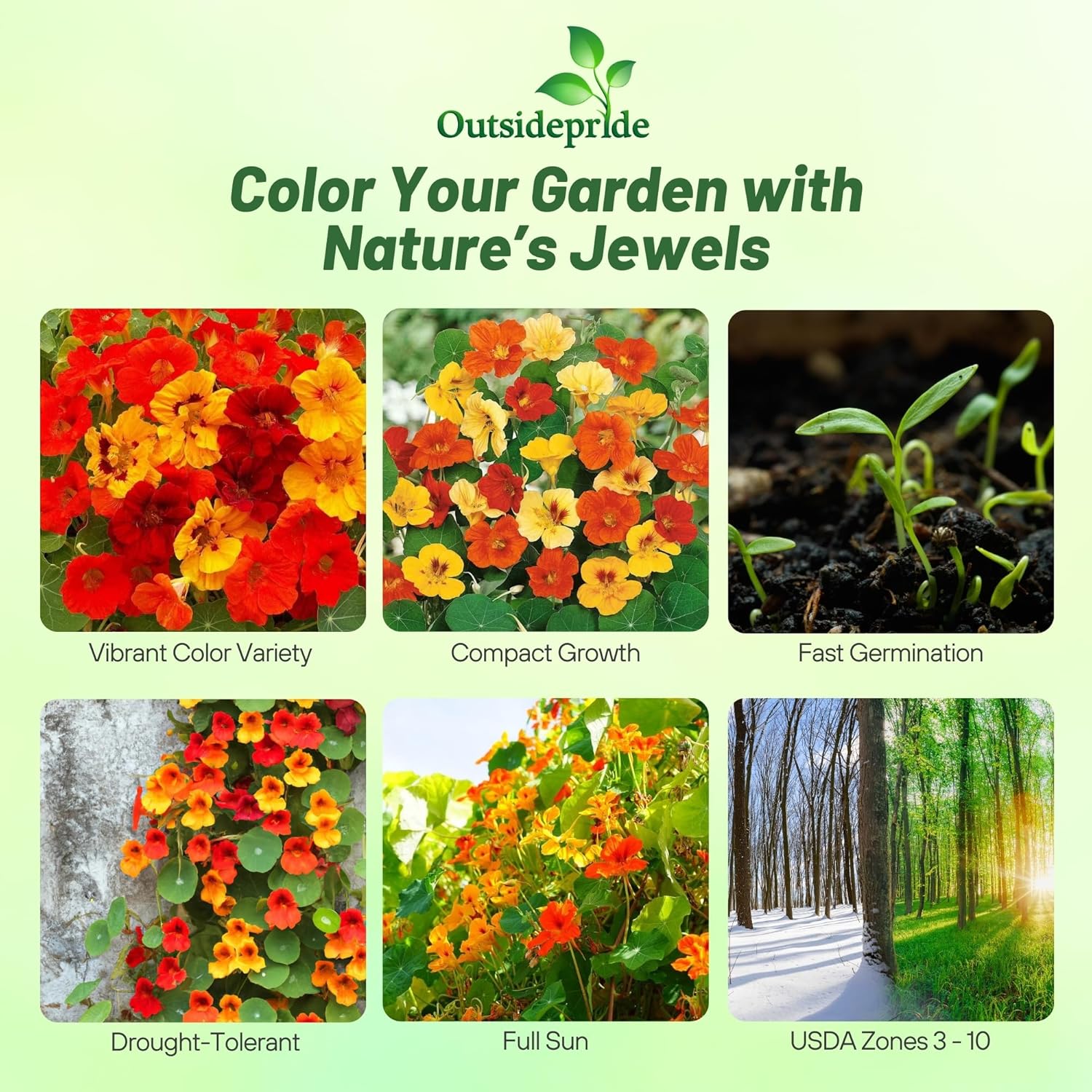
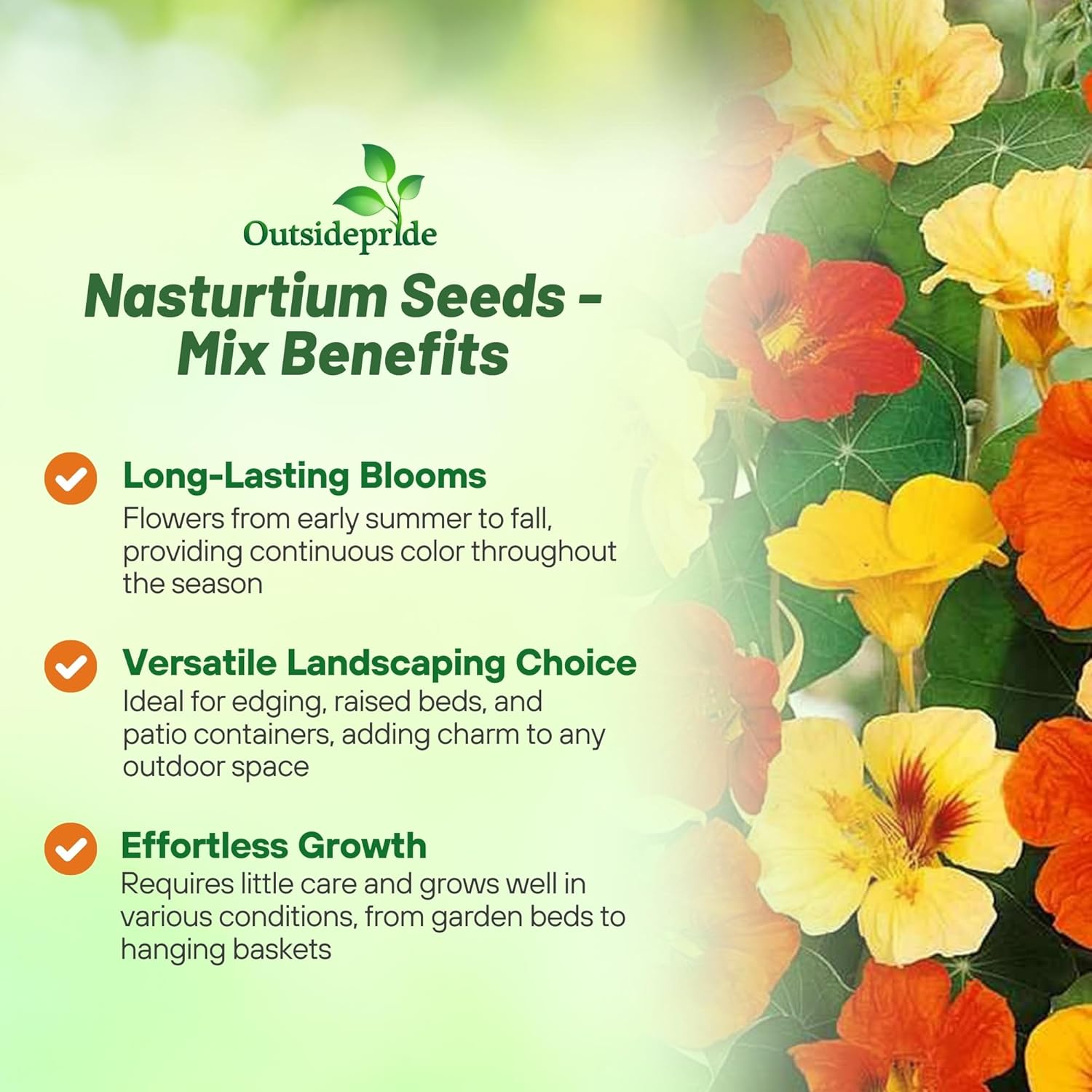

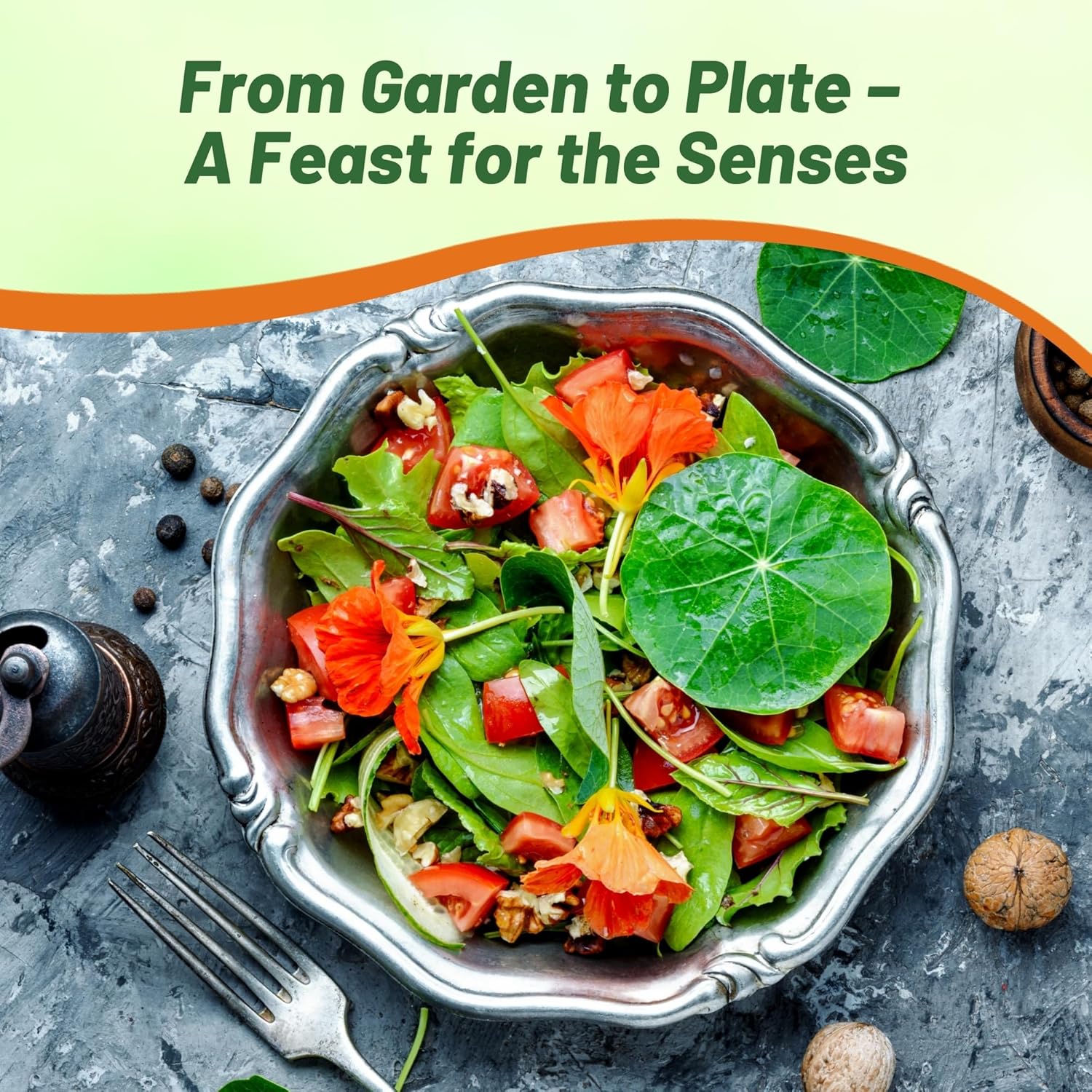
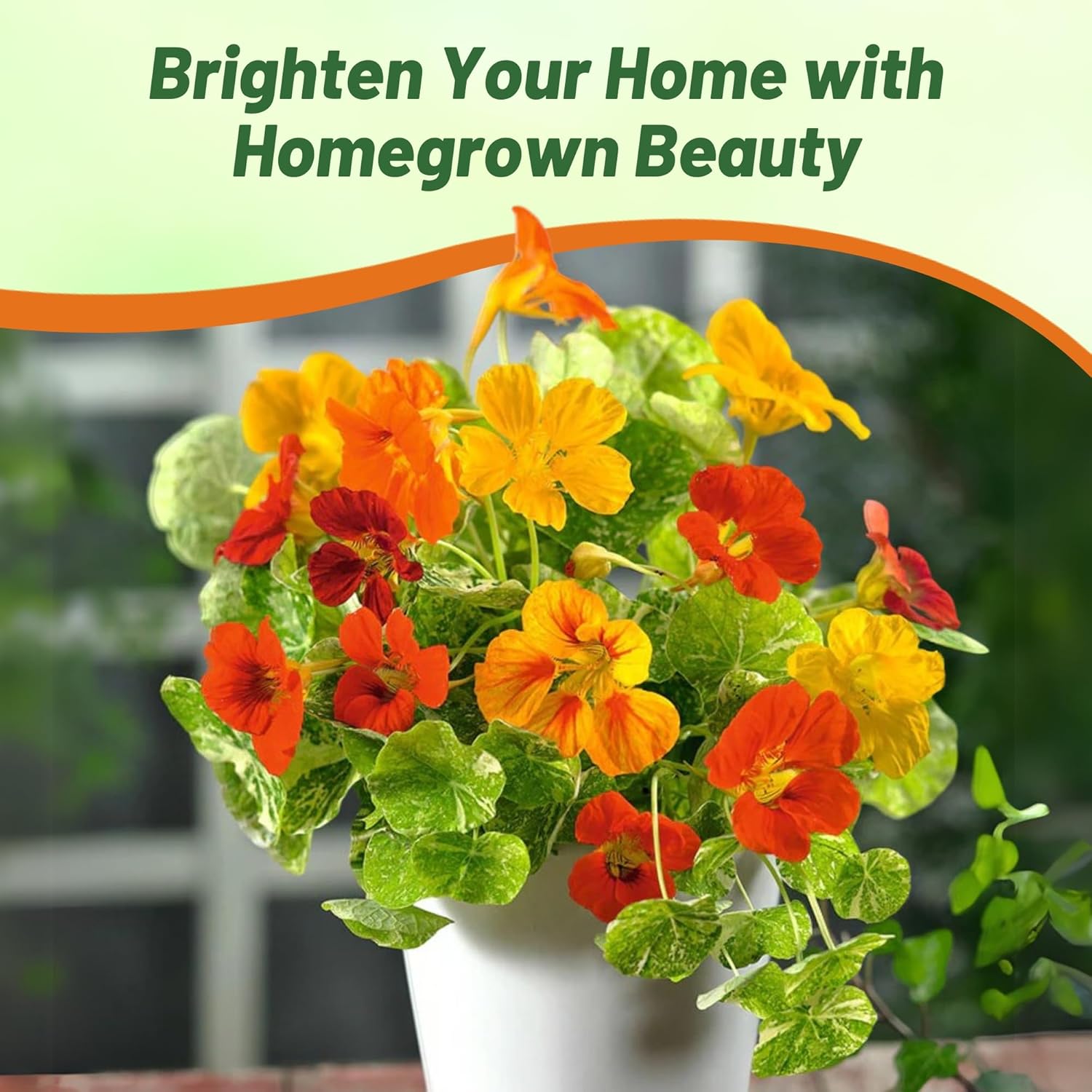

Nasturtium Seeds - Mix
About...
(Tropaeolum Majus Jewel Mix) - Few flowers light up the garden like nasturtiums do! Grow this lovely annual from flower seeds and have blooms from June until first frost. The Jewel mix blossoms are 2 - 3 inches across and come in shades of red, orange and yellow.MORE NASTURTIUM OPTIONS
Planting Directions
TEMPERATURE
65F
AVERAGE GERM TIME
7 - 10 days
LIGHT REQUIRED
No
DEPTH
1/2 inch
SOWING RATE
1 - 2 seeds per plant or 3 1/2 pounds per 1,000 square feet or 150 pou...more 1 - 2 seeds per plant or 3 1/2 pounds per 1,000 square feet or 150 pounds per acre...less
MOISTURE
Keep seeds moist until germination
PLANT SPACING
8 - 12 inches









Nasturtium (Tropaeolum Majus Jewel Mix) - Few flowers light up the garden like nasturtiums do! Grow this lovely annual from flower seeds and have blooms from June until first frost. The Jewel mix blossoms are 2 - 3 inches across and come in shades of red, orange and yellow. The leaves are rounded or shaped like a shield and have a central leaf stalk. The leaves, flowers and seeds are edible, with the leaves having a peppery flavor which makes a great addition to your salads. The seeds were actually used as a pepper substitute during WWII, or you can pickle the seeds when they are still green.
Common Questions
Are the flowers edible?
Yes, flowers have a peppery taste and are used to garnish salads or other dishes. Young leaves have a flavor like watercress and are good in salads.
Why didn’t my nasturtiums flower?
Nasturtiums like a poor soil so be very careful not to over fertilize the plants. The result is pretty plants but no flowers.
Why didn’t my seeds germinate?
Nasturtiums have a thick seed coat and should be soaked or filed with a nail file before sowing to aid in germination.
Do nasturtiums attract pollinators to my garden?
Yes, nasturtiums attract bees, butterflies, hummingbirds and other pollinators are drawn to these flowers.
What plants will benefit from using nasturtiums as a companion plant?
Nasturtiums make a good companion for: broccoli, Brussels sprouts, cabbage, cauliflower, cucumbers, kale, kohlrabi, pumpkins, radish, squash, tomato, and potato.
What are some recommended flowers to plant with nasturtiums?
Sunflowers, lavender, marigold, cosmos, zinnia and asters all look lovely and grow well with nasturtiums.
Do I need to deadhead my flowers?
Yes, to prolong your bloom season you will need to deadhead the flowers.
Planting Directions
TEMPERATURE
68F
AVERAGE GERM TIME
7 - 10 days
LIGHT REQUIRED
No
DEPTH
1/2 inch
SOWING RATE
1 - 2 seeds per plant
MOISTURE
Keep seed moist until germination
PLANT SPACING
8 - 12 inches









Nasturtium (Tropaeolum nanum Top Flowering Single Night & Day) - Mix of yellow and mahogany top flowering nasturtiums giving a night and day appearance. Compact and free-flowering, it is ideal for containers and garden edging. Trailing and climbing plant habit. Try it in baskets, containers, and shady borders. Also known as garden nasturtium and Indian cress.
Nasturtiums like a full sun place in the garden in cooler climates. For the hottest regions, afternoon shade is preferable to the plants. Tropaeolum plants will grow anywhere as an annual, but they will only survive as a perennial in frost-free zones. Care is simple: no fertilizing is required and follow a regular watering schedule giving the plant a chance to dry out in-between irrigations. Before sowing seeds, soak the seeds overnight in warm water. The next day, plant the flower seeds 1/2 inch deep in soil that is weed-free and worked fine and light.
Common Questions
Are the flowers edible?
Yes, flowers have a peppery taste and are used to garnish salads or other dishes. Young leaves have a flavor like watercress and are good in salads.
Why didn’t my nasturtiums flower?
Nasturtiums like a poor soil so be very careful not to over fertilize the plants. The result is pretty plants but no flowers.
Why didn’t my seeds germinate?
Nasturtiums have a thick seed coat and should be soaked or filed with a nail file before sowing to aid in germination.
Do nasturtiums attract pollinators to my garden?
Yes, nasturtiums attract bees, butterflies, hummingbirds and other pollinators are drawn to these flowers.
What plants will benefit from using nasturtiums as a companion plant?
Nasturtiums make a good companion for: broccoli, Brussels sprouts, cabbage, cauliflower, cucumbers, kale, kohlrabi, pumpkins, radish, squash, tomato, and potato.
What are some recommended flowers to plant with nasturtiums?
Sunflowers, lavender, marigold, cosmos, zinnia and asters all look lovely and grow well with nasturtiums.
Do I need to deadhead my flowers?
Yes, to prolong your bloom season you will need to deadhead the flowers.
Planting Directions
TEMPERATURE
68F
AVERAGE GERM TIME
7 - 10 days
LIGHT REQUIRED
No
DEPTH
1/2 inch
SOWING RATE
1 - 2 seeds per plant
MOISTURE
Keep seeds moist until germination
PLANT SPACING
8 - 12 inches









Nasturtium (Tropaeolum majus Zanzibar) - A vibrant mix of bright red, yellow and orange with contrasting dark foliage. Nasturtiums also makes a fine companion to vegetables in the garden by attracting bees and repelling destructive pests, particularly around Brassicas (cabbage, broccoli, cauliflower, kohlrabi, mustard and collard greens, etc.). Nasturtiums are also useful as a barrier planting around your tomatoes and cucumbers, and some gardeners find it a helpful pest deterrent when ringed around young fruit trees.
Nasturtium is easy to grow from seed. Nick or soak the seeds before sowing. Then direct sow into the garden or the final container in which they will grow, or start them indoors 5 to 6 weeks before the last anticipated spring frost in your area. Expect germination to take a week or so. The Nasturtium plants need full sun for best flowering; they will grow in part shade, but the blooms will not be as numerous or large. Poor soil often works better than rich for promoting bloom strength.
Common Questions
Are the flowers edible?
Yes, flowers have a peppery taste and are used to garnish salads or other dishes. Young leaves have a flavor like watercress and are good in salads.
Why didn’t my nasturtiums flower?
Nasturtiums like a poor soil so be very careful not to over fertilize the plants. The result is pretty plants but no flowers.
Why didn’t my seeds germinate?
Nasturtiums have a thick seed coat and should be soaked or filed with a nail file before sowing to aid in germination.
Do nasturtiums attract pollinators to my garden?
Yes, nasturtiums attract bees, butterflies, hummingbirds and other pollinators are drawn to these flowers.
What plants will benefit from using nasturtiums as a companion plant?
Nasturtiums make a good companion for: broccoli, Brussels sprouts, cabbage, cauliflower, cucumbers, kale, kohlrabi, pumpkins, radish, squash, tomato, and potato.
What are some recommended flowers to plant with nasturtiums?
Sunflowers, lavender, marigold, cosmos, zinnia and asters all look lovely and grow well with nasturtiums.
Do I need to deadhead my flowers?
Yes, to prolong your bloom season you will need to deadhead the flowers.
Planting Directions
TEMPERATURE
68F
AVERAGE GERM TIME
7 - 10 days
LIGHT REQUIRED
No
DEPTH
1/2 inch
SOWING RATE
1 - 2 seeds per plant
MOISTURE
Keep seeds moist until germination
PLANT SPACING
8 - 12 inches









Nasturtium (Tropaeolum majus Strawberry Cream) - Attractive mixture of complimentary blotched primrose spotted and red flowers. Ideal in containers or garden borders. Attracts beneficial garden insects. Plants grow to 1 foot tall can spread 1 foot as well. Nasturtiums are easy-to-grow plants perfect for edging paths, planting in beds or adding to containers. Long-spurred blossoms attract hummingbirds, young nasturtium leaves add delicious peppery flavor to salads. Nasturtiums are one of the best mild-weather annual flowers for your garden.
Nasturtiums also makes a fine companion to vegetables in the garden by attracting bees and repelling destructive pests, particularly around Brassicas (cabbage, broccoli, cauliflower, kohlrabi, mustard and collard greens, etc.). Nasturtiums are also useful as a barrier planting around your tomatoes and cucumbers, and some gardeners find it a helpful pest deterrent when ringed around young fruit trees.
Nasturtium is easy to grow from seed. Nick or soak the seeds before sowing. Then direct sow into the garden or the final container in which they will grow, or start them indoors 5 to 6 weeks before the last anticipated spring frost in your area. Expect germination to take a week or so. The Nasturtium plants need full sun for best flowering; they will grow in part shade, but the blooms will not be as numerous or large. Poor soil often works better than rich for promoting bloom strength.
Common Questions
Are the flowers edible?
Yes, flowers have a peppery taste and are used to garnish salads or other dishes. Young leaves have a flavor like watercress and are good in salads.
Why didn’t my nasturtiums flower?
Nasturtiums like a poor soil so be very careful not to over fertilize the plants. The result is pretty plants but no flowers.
Why didn’t my seeds germinate?
Nasturtiums have a thick seed coat and should be soaked or filed with a nail file before sowing to aid in germination.
Do nasturtiums attract pollinators to my garden?
Yes, nasturtiums attract bees, butterflies, hummingbirds and other pollinators are drawn to these flowers.
What plants will benefit from using nasturtiums as a companion plant?
Nasturtiums make a good companion for: broccoli, Brussels sprouts, cabbage, cauliflower, cucumbers, kale, kohlrabi, pumpkins, radish, squash, tomato, and potato.
What are some recommended flowers to plant with nasturtiums?
Sunflowers, lavender, marigold, cosmos, zinnia and asters all look lovely and grow well with nasturtiums.
Do I need to deadhead my flowers?
Yes, to prolong your bloom season you will need to deadhead the flowers.
Planting Directions
TEMPERATURE
68F
AVERAGE GERM TIME
7 - 10 days
LIGHT REQUIRED
No
DEPTH
1/2 inch
SOWING RATE
1 - 2 seeds per plant
MOISTURE
Keeps seeds moist until germination
PLANT SPACING
8 - 12 inches









Nasturtium (Tropaeolum majus Orchid Cream) - An unusual Nasturtium with chameleon like flowers. The color changes from cream with a red splash to fully red. The final flower color depends on weather and temperature. Ideal for planting en-masse in borders and landscapes. The 12 inch high mounding plants are covered in blooms in various states of color transition, and this makes for a quite lively, and unique display.
Nasturtiums also makes a fine companion to vegetables in the garden by attracting bees and repelling destructive pests, particularly around Brassicas (cabbage, broccoli, cauliflower, kohlrabi, mustard and collard greens, etc.). Nasturtiums are also useful as a barrier planting around your tomatoes and cucumbers, and some gardeners find it a helpful pest deterrent when ringed around young fruit trees.
Nasturtium is easy to grow from seed. Nick or soak the seeds before sowing. Then direct sow into the garden or the final container in which they will grow, or start them indoors 5 to 6 weeks before the last anticipated spring frost in your area. Expect germination to take a week or so. The Nasturtium plants need full sun for best flowering; they will grow in part shade, but the blooms will not be as numerous or large. Poor soil often works better than rich for promoting bloom strength.
Common Questions
Are the flowers edible?
Yes, flowers have a peppery taste and are used to garnish salads or other dishes. Young leaves have a flavor like watercress and are good in salads.
Why didn’t my nasturtiums flower?
Nasturtiums like a poor soil so be very careful not to over fertilize the plants. The result is pretty plants but no flowers.
Why didn’t my seeds germinate?
Nasturtiums have a thick seed coat and should be soaked or filed with a nail file before sowing to aid in germination.
Do nasturtiums attract pollinators to my garden?
Yes, nasturtiums attract bees, butterflies, hummingbirds and other pollinators are drawn to these flowers.
What plants will benefit from using nasturtiums as a companion plant?
Nasturtiums make a good companion for: broccoli, Brussels sprouts, cabbage, cauliflower, cucumbers, kale, kohlrabi, pumpkins, radish, squash, tomato, and potato.
What are some recommended flowers to plant with nasturtiums?
Sunflowers, lavender, marigold, cosmos, zinnia and asters all look lovely and grow well with nasturtiums.
Do I need to deadhead my flowers?
Yes, to prolong your bloom season you will need to deadhead the flowers.
Planting Directions
TEMPERATURE
68F
AVERAGE GERM TIME
7 - 10 days
LIGHT REQUIRED
No
DEPTH
1/2 inch
SOWING RATE
1 - 2 seeds per plant
MOISTURE
Keep seeds moist until germination
PLANT SPACING
8 - 12 inches









Nasturtium (Tropaeolum majus Hawaiian Mix) - Add a tropical touch to pots and borders with Nasturtium 'Hawaiian Mix'. This vibrant blend of yellow, pink, apricot and cream flowers will brighten up any garden, flowering all summer long.
These pretty blossoms atop lily pad-shaped leaves make a lovely garden tapestry. Hawaiian mix grows readily in pots or window boxes, or plant in garden beds to softly drape and cover bare spots or fill in borders. Both flowers and leaves of nasturtiums are edible with a spicy flavor like watercress. They make tasty additions to salads or sandwiches.
Nasturtiums also makes a fine companion to vegetables in the garden by attracting bees and repelling destructive pests, particularly around Brassicas (cabbage, broccoli, cauliflower, kohlrabi, mustard and collard greens, etc.). Nasturtiums are also useful as a barrier planting around your tomatoes and cucumbers, and some gardeners find it a helpful pest deterrent when ringed around young fruit trees.
Nasturtium is easy to grow from seed. Nick or soak the seeds before sowing. Then direct sow into the garden or the final container in which they will grow, or start them indoors 5 to 6 weeks before the last anticipated spring frost in your area. Expect germination to take a week or so. The Nasturtium plants need full sun for best flowering; they will grow in part shade, but the blooms will not be as numerous or large. Poor soil often works better than rich for promoting bloom strength.
Common Questions
Are the flowers edible?
Yes, flowers have a peppery taste and are used to garnish salads or other dishes. Young leaves have a flavor like watercress and are good in salads.
Why didn’t my nasturtiums flower?
Nasturtiums like a poor soil so be very careful not to over fertilize the plants. The result is pretty plants but no flowers.
Why didn’t my seeds germinate?
Nasturtiums have a thick seed coat and should be soaked or filed with a nail file before sowing to aid in germination.
Do nasturtiums attract pollinators to my garden?
Yes, nasturtiums attract bees, butterflies, hummingbirds and other pollinators are drawn to these flowers.
What plants will benefit from using nasturtiums as a companion plant?
Nasturtiums make a good companion for: broccoli, Brussels sprouts, cabbage, cauliflower, cucumbers, kale, kohlrabi, pumpkins, radish, squash, tomato, and potato.
What are some recommended flowers to plant with nasturtiums?
Sunflowers, lavender, marigold, cosmos, zinnia and asters all look lovely and grow well with nasturtiums.
Do I need to deadhead my flowers?
Yes, to prolong your bloom season you will need to deadhead the flowers.
Planting Directions
TEMPERATURE
68F
AVERAGE GERM TIME
7 - 10 days
LIGHT REQUIRED
No
DEPTH
1/2 inch
SOWING RATE
1 - 2 seeds per plant
MOISTURE
Keep seeds moist until germination
PLANT SPACING
8 - 12 inches
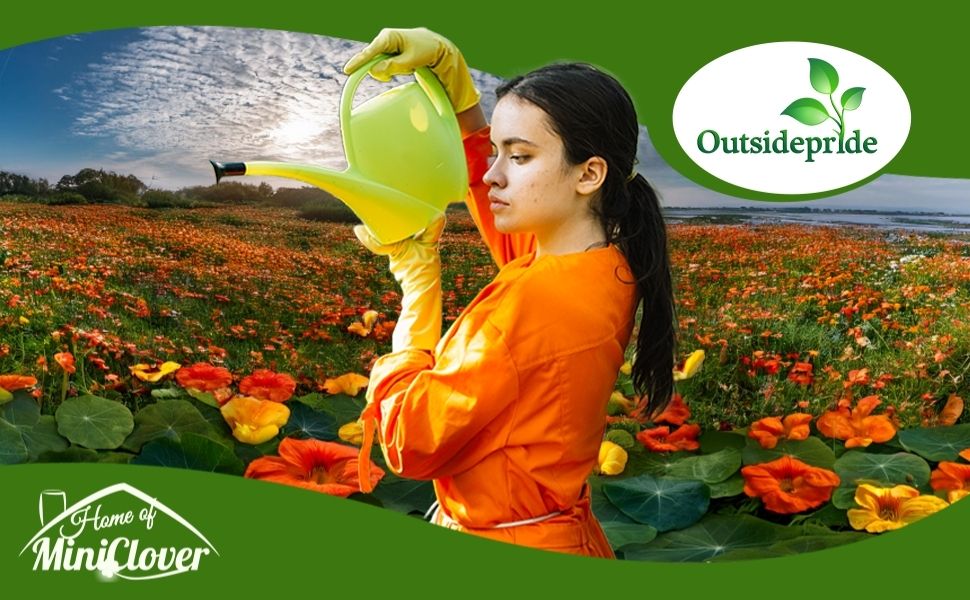
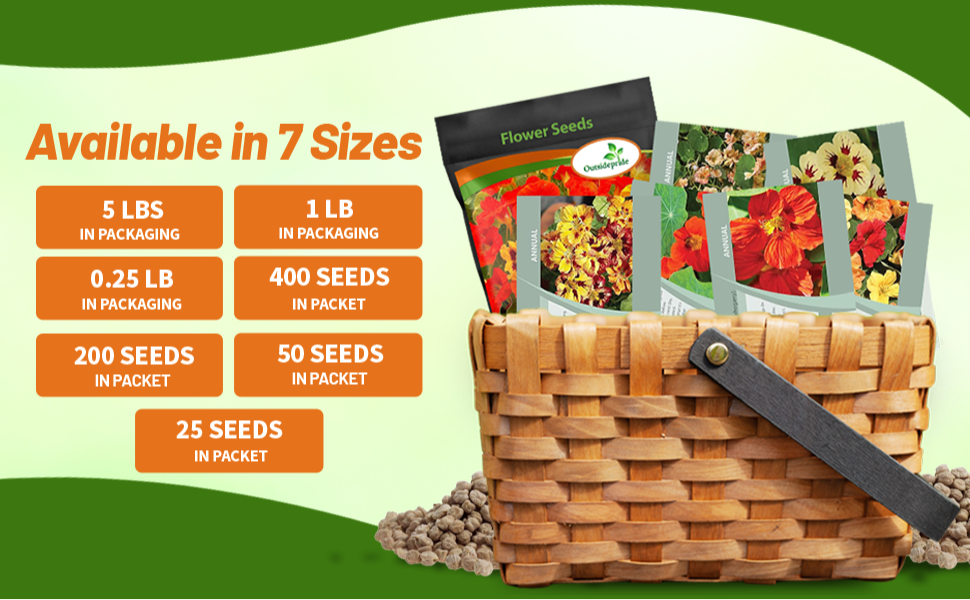
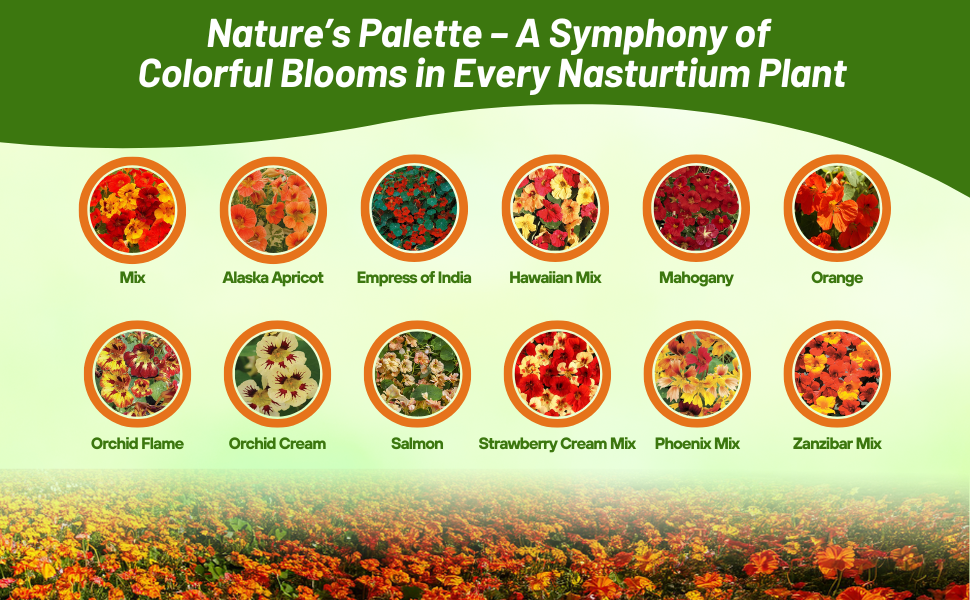
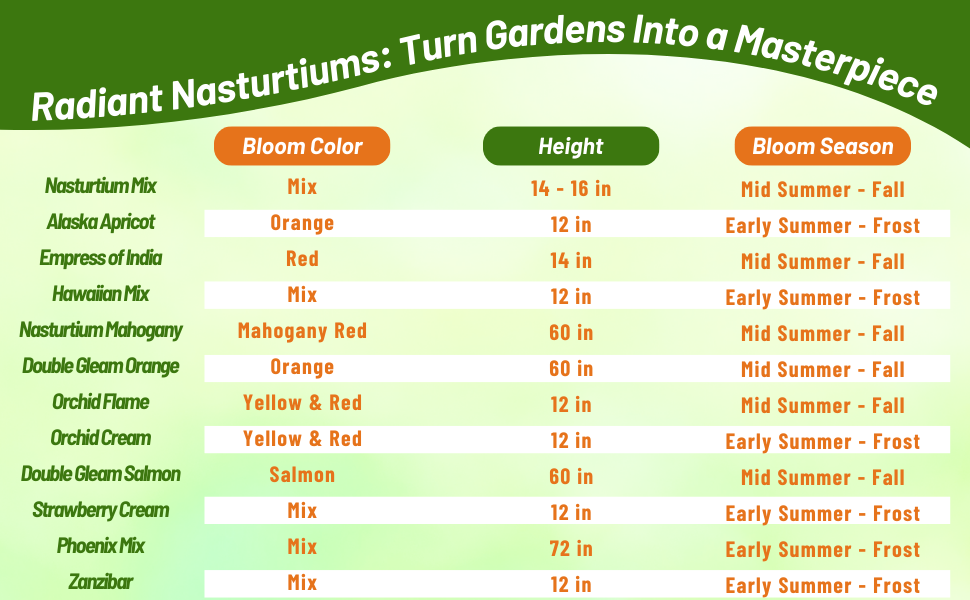

Nasturtium (Tropaeolum majus Alaska Apricot) - Excellent selection of this Alaska separate color with bright Apricot flowers held above variagated foliage. Alaska Apricot is a mounding variety only reaching 12 inches in height. It is also a quick grower blooming heavily by early summer and keeps on going until the weather turns cold.
Warm apricot-colored flowers are held above handsome foliage. Alaska Apricot nasturtium produces small, beautifully variegated leaves which are the perfect foil for the showy flowers. Blooms are held above the leaves for optimal viewing. Alaska Apricot nasturtium plants are compact and tidy.
Nasturtiums also makes a fine companion to vegetables in the garden by attracting bees and repelling destructive pests, particularly around Brassicas (cabbage, broccoli, cauliflower, kohlrabi, mustard and collard greens, etc.). Alaska Apricot Nasturtium is also useful as a barrier planting around your tomatoes and cucumbers, and some gardeners find it a helpful pest deterrent when ringed around young fruit trees.
Nasturtium is easy to grow from seed. Nick or soak the seeds before sowing. Then direct sow into the garden or the final container in which they will grow, or start them indoors 5 to 6 weeks before the last anticipated spring frost in your area. Expect germination to take a week or so. The Nasturtium plants need full sun for best flowering; they will grow in part shade, but the blooms will not be as numerous or large. Poor soil often works better than rich for promoting bloom strength.
Common Questions
Are the flowers edible?
Yes, flowers have a peppery taste and are used to garnish salads or other dishes. Young leaves have a flavor like watercress and are good in salads.
Why didn’t my nasturtiums flower?
Nasturtiums like a poor soil so be very careful not to over fertilize the plants. The result is pretty plants but no flowers.
Why didn’t my seeds germinate?
Nasturtiums have a thick seed coat and should be soaked or filed with a nail file before sowing to aid in germination.
Do nasturtiums attract pollinators to my garden?
Yes, nasturtiums attract bees, butterflies, hummingbirds and other pollinators are drawn to these flowers.
What plants will benefit from using nasturtiums as a companion plant?
Nasturtiums make a good companion for: broccoli, Brussels sprouts, cabbage, cauliflower, cucumbers, kale, kohlrabi, pumpkins, radish, squash, tomato, and potato.
What are some recommended flowers to plant with nasturtiums?
Sunflowers, lavender, marigold, cosmos, zinnia and asters all look lovely and grow well with nasturtiums.
Do I need to deadhead my flowers?
Yes, to prolong your bloom season you will need to deadhead the flowers.
Planting Directions
TEMPERATURE
68F
AVERAGE GERM TIME
7 - 10 days
LIGHT REQUIRED
No
DEPTH
1/2 inch
SOWING RATE
1 - 2 seeds per plant
MOISTURE
Keep seeds moist until germination
PLANT SPACING
8 - 12 inches









Nasturtium (Tropaeolum Majus Orchid Flame) - These beautiful flowers have bright yellow with red edges. As the plants keep developing, the red creeps farther and farther across the bloom, creating all sorts of uniquely beautiful patterns. No two flowers will be just alike on this unique nasturtium.
Orchid Flame is a trailing variet spreading or cascading 3 to 4 feet tall; however, it only reaches 12 inches in height. This makes it a great choice for hanging baskets or trellises. It is also a quick grower blooming heavily by early summer and keeps on going until the weather turns cold.
The flowers on Orchid Flame Nasturtium are unlike those of any other in the garden. Measuring 2 inches across, they stand out amongst any other flowers. Like all nasturtiums, they are edible, making lovely embellishments on cakes and salads. You can also use them hanging baskets, beds, containers, ground covers, as an ornamental, or a climbing vine. Their only downfall is they do not make a good cut flower.
Nasturtiums also makes a fine companion to vegetables in the garden by attracting bees and repelling destructive pests, particularly around Brassicas (cabbage, broccoli, cauliflower, kohlrabi, mustard and collard greens, etc.). Orchid Flame Nasturtium is also useful as a barrier planting around your tomatoes and cucumbers, and some gardeners find it a helpful pest deterrent when ringed around young fruit trees.
Nasturtium is easy to grow from seed. Nick or soak the seeds before sowing. Then direct sow into the garden or the final container in which they will grow, or start them indoors 5 to 6 weeks before the last anticipated spring frost in your area. Expect germination to take a week or so. The Orchid Flame Nasturtium plants need full sun for best flowering; they will grow in part shade, but the blooms will not be as numerous or large. Poor soil often works better than rich for promoting bloom strength.
Common Questions
Are the flowers edible?
Yes, flowers have a peppery taste and are used to garnish salads or other dishes. Young leaves have a flavor like watercress and are good in salads.
Why didn’t my nasturtiums flower?
Nasturtiums like a poor soil so be very careful not to over fertilize the plants. The result is pretty plants but no flowers.
Why didn’t my seeds germinate?
Nasturtiums have a thick seed coat and should be soaked or filed with a nail file before sowing to aid in germination.
Do nasturtiums attract pollinators to my garden?
Yes, nasturtiums attract bees, butterflies, hummingbirds and other pollinators are drawn to these flowers.
What plants will benefit from using nasturtiums as a companion plant?
Nasturtiums make a good companion for: broccoli, Brussels sprouts, cabbage, cauliflower, cucumbers, kale, kohlrabi, pumpkins, radish, squash, tomato, and potato.
What are some recommended flowers to plant with nasturtiums?
Sunflowers, lavender, marigold, cosmos, zinnia and asters all look lovely and grow well with nasturtiums.
Do I need to deadhead my flowers?
Yes, to prolong your bloom season you will need to deadhead the flowers.
































